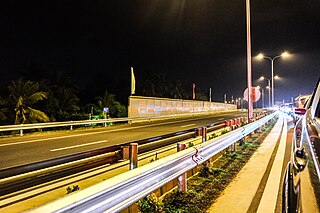
Transport in Sri Lanka is based on its road network, which is centred on the country's commercial capital Colombo. A rail network handles a portion of Sri Lanka's transport needs. There are navigable waterways, harbours and three international airports: in Katunayake, 35 kilometres (22 mi) north of Colombo, in Hambantota, and in Jaffna.
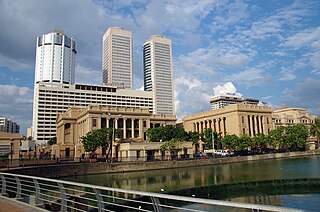
Colombo is the executive and judicial capital and largest city of Sri Lanka by population. According to the Brookings Institution, Colombo metropolitan area has a population of 5.6 million, and 752,993 in the Municipality. It is the financial centre of the island and a tourist destination. It is located on the west coast of the island and adjacent to the Greater Colombo area which includes Sri Jayawardenepura Kotte, the legislative capital of Sri Lanka, and Dehiwala-Mount Lavinia. Colombo is often referred to as the capital since Sri Jayawardenepura Kotte is itself within the urban/suburban area of Colombo. It is also the administrative capital of the Western Province and the district capital of Colombo District. Colombo is a busy and vibrant city with a mixture of modern life, colonial buildings and monuments.
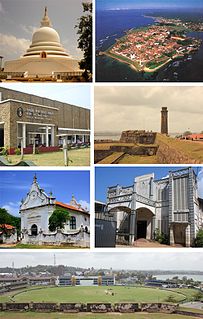
Galle is a major city in Sri Lanka, situated on the southwestern tip, 119 kilometres (74 mi) from Colombo. Galle is the provincial capital and largest city of Southern Province, Sri Lanka and is the capital of Galle District.

The 2004 Sri Lanka tsunami-rail disaster is the largest single rail disaster in world history by death toll, with 1,700 fatalities or more. It occurred when a crowded passenger train was destroyed on a coastal railway in Sri Lanka by a tsunami which followed the 2004 Indian Ocean earthquake. The tsunami subsequently caused over 30,000 reported deaths and billions of rupees in property damage in the coastal areas of Sri Lanka.

Matara is a major city in Sri Lanka, on the southern coast of Southern Province. It is the second largest city in Southern Province. It is 160 km (99 mi) from Colombo. It is a major commercial hub, and it is the administrative capital and largest city of Matara District.

Slave Island also known as Kampong Kertel and Kompanna Veediya is a suburb in Colombo, Sri Lanka, located directly south of the Fort. The suburb contains Beira Lake, a large lake and its esplanade is visited by many for recreation. Slave Island is mostly a commercial area with hotels, shopping centres, street food stalls, and is known for its multicultural, especially Malay heritage.
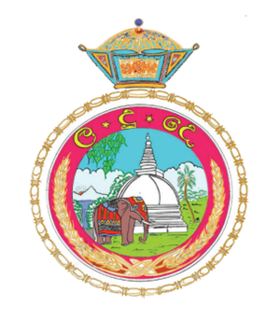
The Sri Lanka Railway Department is Sri Lanka's railway owner and primary operator. As part of the Sri Lankan government, it is overseen by the Ministry of Transport. Founded in 1858 as the Ceylon Government Railway, it operates the nation's railways and links Colombo with other population centres and tourist destinations.
Ambalangoda is a coastal town located in Galle District, Southern Province of Sri Lanka. Governed by Ambalangoda Urban Council, the town is famous for its ancient demon masks and devil dancers. Situated approximately 107 kilometres (66 mi) south of Colombo, it sits on an elevation of 13 metres (43 ft) above the sea level.

The Kelani Valley railway line in Sri Lanka, covering the breadth of Colombo District. The line is owned, maintained, and operated by Sri Lanka Railways.
Maradana is a suburb of Colombo, Sri Lanka. Maradana is the site of Maradana Railway Station, one of the primary railway hubs in the country, serving intercity rail and commuter rail. Maradana also has many railway yards and running sheds. A technical college, many national schools, the Lotus Tower, and business institutions are also located in the area.

Dutch colonial architecture refers to the various style of Dutch architecture built across the Dutch Empire. Though most of the buildings were designed by Dutch architects and dictated by Western architectural styles, even the most ardent style-purists among architects could not escape the forces of context and culture. Dutch colonial architecture often is a result of climatological adaptions or the use of local building materials - and more importantly, the rich and diverse cultural contexts. In this hybridity lies the quality of these buildings. Architecture shows that the strict racial taxonomy of a colonial system could not be maintained.
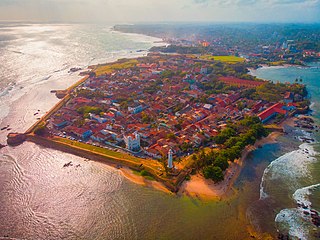
Galle Fort, in the Bay of Galle on the southwest coast of Sri Lanka, was built first in 1588 by the Portuguese, then extensively fortified by the Dutch during the 17th century from 1649 onwards. It is a historical, archaeological and architectural heritage monument, which even after more than 432 years maintains a polished appearance, due to extensive reconstruction work done by Archaeological Department of Sri Lanka.

Sri Lanka Railways Class S11 is a diesel multiple-unit (DMU) train, built for Sri Lanka Railways by Integral Coach Factory and imported through RITES Ltd, an Indian state infrastructure corporation on a line of credit extended by the Indian Government. They were built to replace locomotive-hauled passenger trains. Twenty S11 DMUs were ordered to strengthen long-distance travel on the Coastal Line from Colombo to Matara.
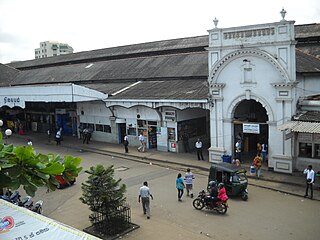
Fort railway station is a major rail hub in Colombo, Sri Lanka. The station is served by Sri Lanka Railways, with many inter-city and commuter trains entering each day. Fort Station is the main rail gateway to central Colombo; it is the terminus of most intercity trains in the country.
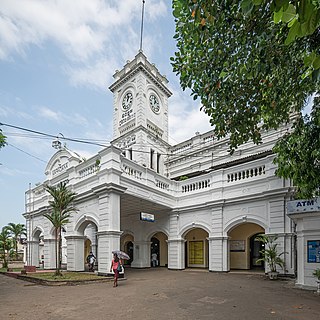
Maradana Railway Station is a major rail hub in Colombo, Sri Lanka. The station is served by Sri Lanka Railways, with many inter-city and commuter trains entering each day. It is the terminus of several intercity trains.
Samudra Devi is a daily passenger train in Sri Lanka, operated by Sri Lanka Railways. The train runs on the Coastal line, from Galle to Maradana in the morning, and the return service is in the evening.

Galle railway station is a railway station in the southern city of Galle in Sri Lanka. Owned by Sri Lanka Railways, the state-run railway operator, the station is part of the Coast Line, which links Sri Lanka's south coast with the Colombo.

The coastal line is a major railway line in Sri Lanka, running between Colombo Fort and Beliatta, via Galle and Matara. Operated by Sri Lanka Railways, the line includes some of the busiest rail services in the country. The line has been extended to Beliatta on 8 April 2019 and is proposed to be extended to Kataragama, via Hambantota. With a designed maximum speed of 100 km/h (62 mph) between Kalutara and Matara, and a maximum speed of 120 km/h (75 mph) between Matara and Beliatta, the line is one of the fastest in Sri Lanka.
Ruhunu Kumari is a daytime passenger train that runs between Colombo and Matara in Sri Lanka.
Rajarata Rejini is a daytime passenger train that runs between Vavuniya and Beliatta via Colombo Fort in Sri Lanka.
















